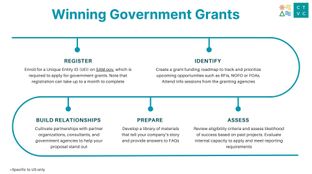
🌎 Get ready with me: Government grants edition 💅💵
A founder’s guide to winning non-dilutive funding with Elemental Excelerator
This past week we interviewed Austin Whitman, founding CEO of Climate Neutral, an independent non-profit organization working to accelerate the transition to a low-carbon world.

This past week we interviewed Austin Whitman, founding CEO of Climate Neutral, an independent non-profit organization working to accelerate the transition to a low-carbon world. The Climate Neutral Certified label is a clear symbol that a company has measured and offset its carbon footprint, and implemented plans to drive carbon emissions out of its supply chain. Climate Neutral aims to demonstrate that carbon neutrality is affordable today for every company – and critical for the global climate.
It started with two successful entrepreneurs who wanted to do more about climate change. The founders of Peak Design and BioLite each had a nagging feeling that despite baking positive climate impact into the core of their operations since inception, they could still be doing more about climate change. They were missing a playbook for how to take operationally achievable, yet environmentally meaningful action that they could then communicate to their customers.
I came into the conversation after basically being out of the carbon market for 10 years; I worked at a clean tech software company (FirstFuel Software) and prior to that was deep in the sustainable investing world (Cambridge Associates, Climate Change Capital). After riding the hype rollercoaster of the first wave of carbon offsets, it was intriguing to me that these entrepreneurs were now thinking about offsets as a mechanism for attacking the consumer market. I was excited to build something and, in the fall of 2018, decided to set up a nonprofit to help companies through their carbon offsetting journeys.
I think the basic thing that has been left out of the equation is a simple, clear, and hopeful message that consumers can grab onto. This is increasingly important when 2/3rds of Americans think the government should be doing more about climate change, 3/4ths of Americans think climate change is a real problem, and yet 0 have a meaningful climate policy they benefit from.
We think there’s an opportunity to engage consumers in a clearer way and mobilize a significant chunk of the US economy to direct it towards companies and brands that are measuring and doing something about their carbon footprint. So, consumers come first in this equation.
In 2018 we saw a major uptick in consumer concern about climate change. There was a big report which stuck in people’s heads that we have just 12 years left to do something about climate. Clearly, if you say the right thing and provide something that is easy for people to grasp, the message will hit home. I can’t explain the range of factors as to why this was the case, but so many people that I have talked to cite this as the turning point in their concern, and their desire to do something. The question now becomes what we should do?
Yes, we should go out and vote, but voting is no guarantee and it is a long process with a lot of sausage making. We see an opportunity here to directly channel funds into carbon offsetting projects that become a near-term decarbonization solution while companies build longer-term mitigation strategies.
The basic engine only runs if we have a label that consumers want and, because consumers want it, that companies want too, and then have to invest in decarbonization through offsetting and reductions. That’s the basic engine; it loses momentum if any of these pieces break.
First we have to make something that consumers want: the label has to be clear and signifies meaningful action against climate change. That way, when consumers buy something with the label on it, even though they may not quite understand the technical details, they trust that it’s a sign that the company is doing what it should be doing. It becomes a filtering mechanism for what they look to buy.
One of the ways that we are trying to drive recognizability of the label is to recruit companies which are willing to promote the label to their consumers. Even though we have a tiny marketing budget, it snowballs by harnessing the marketing of our certified companies – which benefits everybody since the more people who know about the label, the more people want it, and the more value it drives. It’s all about having that consumer demand first, and then when more companies see consumer demand, they’ll respond by wanting the label for themselves.
We’ve benefited from early adopters who were willing to jump into this before anyone knew what Climate Neutral was. We now have 105 certified companies.
To get to the next level, we have to jump to the second step; the companies have to want it. Many companies want to do something about climate change abstractly but they don’t have the resources to do it comprehensively. We come to them with a clear process of outlined steps, time expectations, and an approachable budget. Not to mention a simple vocabulary of pre-defined carbon neutrality branding.
Today, companies have very few tools to measure their carbon footprint in a credible way without hiring a consultant. Hiring a footprinting consultant doesn’t feel worth it – they cost $30,000 to $40,000 and you’re left with an estimate that’s plus or minus 15% with no actionable next steps. We’ve built a piece of software designed to accurately and quickly get companies some basic fluency in carbon emissions and pin down their carbon footprint. It’s been amazingly eye opening to see how little you have to do to provide a lot of value in this space because the toolbox is essentially empty.
The final piece is to demystify carbon offsets themselves. We work with experts at the top levels of the carbon offset NGO and consulting worlds to define a set of standards and a common approach across all of our companies to build trust that the money that companies are putting into carbon neutrality is actually having positive impact and being put to good use.
Once we’ve shown companies what offsetting quantity they’re targeting, the key thing is to make sure that the money goes toward real impact. We have relationships with many project developers and brokers in identifying available supply that meets our criteria and portfolio allocation requirements. The rest of the process is pretty straightforward. We review the inventory, negotiate on the contract and price point, allocate the projects between our companies’ pooled demand, and make the purchase. I’d say that the voluntary market is pretty strong in terms of total supply and quality of the brokers. There are even a handful of exchanges that are attempting to add liquidity to the market to make it look more like commodity exchange.
We take this seriously and actually have two advisory committees that guide our assessment standards. Even though the voluntary market is tiny in overall demand today, we want to be an arbiter of what should and shouldn’t be done with carbon credits in the future marketplace when this inevitably scales. Recognizing that the market today isn’t perfect, we’re working to improve quality through buying credits with the following 6 characteristics:
We target $5/ ton which is reflective of where most of the market is to date. We stay away from credits priced at $.60 to $0.70/ ton which have been on the shelf for a while from the UN Clean Development Mechanism. Likewise, it’s hard to find at scale significantly more expensive projects in the $30 to $40/ ton range, and we’re buying in volume.
It’s a very interesting element of the overall equation: many argue that carbon should have a higher price per ton. There’s also a tradeoff between public policy price and market price – that’s a really important consideration. When we work with a company, we are requiring comprehensive coverage of all emissions from the supply chain down through product delivery. Public policy often takes a much narrower approach to coverage. So, a company could pay $4 or $5/ ton using our broad boundaries, but that may be equivalent to paying $60 to $70/ ton using the narrow boundaries that a policy considers a company to be subjected to. The important thing is to understand the tradeoff between volume coverage and price.
First off, I commend Stripe for the use of their platform for thinking about creative ways to deal with climate change. We tell our companies to expect to spend 0.3% to 0.4% of revenues to offset their entire carbon footprint. By that measure, the companies that we are working with are doing 10x what Stripe has done with that million dollar commitment.
We try to impress upon companies that this is an incredibly affordable undertaking. And even in difficult economic times, companies have said that the benefits far outweigh the costs.
Of the 150 companies that we’d been in conversation with for 2020, we’ve already certified 105. And we’ve had companies come back to us in the last 2 weeks, saying that this is the first thing that we want to add back to our operating goals now that the economic environment is a little bit clearer. Companies see this as a meaningful goal, so there’s been a very low attrition rate despite the fact that many of our companies are small consumer companies that have been hit the worst by COVID.
This commitment is a key part of their reemergence. They want to be able to talk about something positive and share the work that they have done against climate change. It’s woven into their core brand message in a way that I never really expected.
We are raising, which as a nonprofit means that we’re looking for foundation funding. We’re kicking off a fellowship with the Mulago Foundation that’s all about impact at scale, and have also been talking to a range of large financial institutions which see a lot of synergy between our work and their belief that market-based solutions are essential. We’ve seen a lot of traction over the past 18 months, but there’s no doubt that we need more money to keep growing beyond our hardworking team of 4.
Another interesting lever is the venture capital community’s ability to push footprinting and offsetting across their portfolio. Although early venture-backed businesses don’t have a significant carbon footprint today, with growth expectations their footprint should be very significant in 2-4 years. We‘ve talked to some folks in Europe (Leaders for Climate Action) who have started to rethink the basic contract between VCs and their portfolio companies. These folks have written into their term sheets a requirement that companies fully disclose climate impacts each year (or quarter). It’s an interesting small addition to a term sheet that trains everyone to think about carbon. We hope that we can be a resource to venture firms who have portfolio companies that are looking to operationalize carbon offsetting – one dream scenario would be that an investor’s entire portfolio gets Climate Neutral certified.
We actively respond to all inquiries to our general contact and encourage interested companies to get in the certification queue through the join us form on our website.
Our core success metric is volume of offset carbon. We’ve had a great group of startups, and are also expanding with larger footprint companies. Companies that are thinking about how this can become a core part of their brand and are excited to engage with their customers about this are especially interesting to us.
Interested in more content like this? Subscribe to our weekly newsletter on Climate Tech below!

A founder’s guide to winning non-dilutive funding with Elemental Excelerator

Infrastructure investing for impact with Banyan Infrastructure's Amanda Li

Venturing into nature with Diego Saez-Gil at Pachama